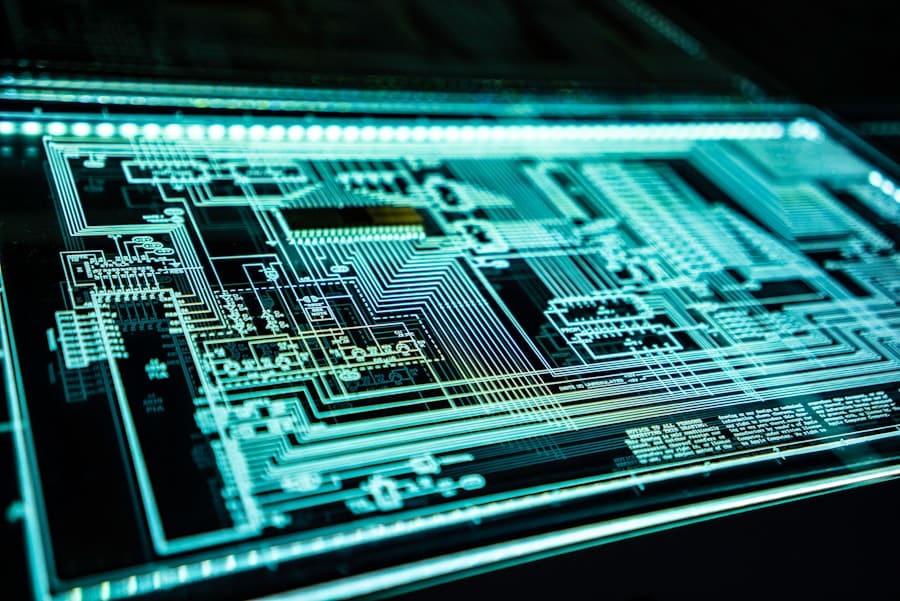The integration of Internet of Things (IoT) devices in healthcare has revolutionized patient care, enabling real-time monitoring, data collection, and improved operational efficiency. However, this technological advancement comes with significant cybersecurity risks. The sensitive nature of healthcare data, which includes personal health information (PHI), makes it a prime target for cybercriminals.
A breach in cybersecurity can lead to unauthorized access to patient records, identity theft, and even manipulation of medical devices, potentially endangering patient safety. As healthcare organizations increasingly rely on IoT devices for critical functions, the importance of robust cybersecurity measures cannot be overstated. Moreover, the interconnectedness of IoT devices creates a complex web of vulnerabilities.
Each device, whether it be a wearable health monitor or a smart infusion pump, can serve as an entry point for cyberattacks. The consequences of such breaches extend beyond financial losses; they can erode patient trust and damage the reputation of healthcare providers. For instance, the 2017 WannaCry ransomware attack affected numerous healthcare facilities worldwide, disrupting services and highlighting the urgent need for comprehensive cybersecurity strategies.
As the healthcare sector continues to embrace IoT technology, prioritizing cybersecurity is essential to safeguard both patient data and the integrity of healthcare systems.
Key Takeaways
- Cybersecurity in healthcare IoT devices is crucial for protecting patient data and ensuring the safety and reliability of medical devices.
- Common vulnerabilities in healthcare IoT devices include weak authentication, insecure network connections, and lack of encryption.
- Cybersecurity tools such as firewalls, antivirus software, and network monitoring systems are used to protect healthcare IoT devices from cyber threats.
- Encryption plays a vital role in securing healthcare IoT devices by encoding sensitive data and preventing unauthorized access.
- Regular software updates are essential for healthcare IoT devices to patch security vulnerabilities and protect against emerging threats.
Common Vulnerabilities in Healthcare IoT Devices
Healthcare IoT devices are often plagued by a variety of vulnerabilities that can be exploited by malicious actors. One prevalent issue is the lack of standardized security protocols across different devices and manufacturers. Many IoT devices are designed with convenience in mind, often sacrificing security features for ease of use.
This can result in weak default passwords, inadequate encryption, and insufficient authentication mechanisms. For example, a study by the Ponemon Institute found that 70% of healthcare organizations reported that their IoT devices had been compromised due to weak security practices. Another significant vulnerability lies in the software used by these devices.
Many healthcare IoT devices run on outdated operating systems or have unpatched software vulnerabilities that can be easily exploited. Cybercriminals often scan networks for devices running outdated software, taking advantage of known vulnerabilities to gain unauthorized access. Additionally, the sheer volume of connected devices in a healthcare setting increases the attack surface, making it challenging for IT teams to monitor and secure every device effectively.
The complexity of managing these devices can lead to oversights in security protocols, further exacerbating the risk of cyberattacks.
Types of Cybersecurity Tools Used to Protect Healthcare IoT Devices

To mitigate the risks associated with healthcare IoT devices, organizations employ a variety of cybersecurity tools designed to enhance security and protect sensitive data.
By isolating IoT devices from critical systems and sensitive data repositories, healthcare organizations can reduce the risk of widespread attacks.
This approach not only enhances security but also simplifies monitoring and management. Another critical tool is endpoint security solutions that specifically target IoT devices. These solutions often include advanced threat detection capabilities that utilize machine learning algorithms to identify unusual behavior patterns indicative of a cyberattack.
For instance, if an infusion pump begins transmitting data at an unusual frequency or to an unauthorized location, the endpoint security system can flag this activity for further investigation. Additionally, security information and event management (SIEM) systems play a vital role in aggregating and analyzing security data from various sources, providing real-time insights into potential threats and enabling rapid response to incidents.
Role of Encryption in Securing Healthcare IoT Devices
Encryption serves as a cornerstone of cybersecurity for healthcare IoT devices by ensuring that sensitive data remains confidential and protected from unauthorized access. When data is transmitted between devices or stored on servers, encryption transforms it into an unreadable format that can only be deciphered by authorized parties with the correct decryption keys. This is particularly crucial in healthcare settings where patient data is highly sensitive and subject to strict regulatory requirements such as HIPAA (Health Insurance Portability and Accountability Act) in the United States.
Implementing encryption protocols not only protects data at rest but also secures data in transit.
Furthermore, end-to-end encryption can be employed to safeguard communications between devices and healthcare providers, ensuring that patient information is only accessible to those who are authorized to view it.
As cyber threats continue to evolve, robust encryption practices are essential for maintaining the integrity and confidentiality of healthcare data.
The Importance of Regular Software Updates for Healthcare IoT Devices
Regular software updates are critical for maintaining the security and functionality of healthcare IoT devices. Manufacturers frequently release updates to address known vulnerabilities, improve performance, and enhance security features. However, many healthcare organizations struggle with implementing these updates consistently due to operational challenges or lack of awareness about their importance.
Failing to apply updates can leave devices exposed to cyber threats that exploit known vulnerabilities. For instance, a notable case involved the Medtronic insulin pump, which was found to have vulnerabilities that could allow unauthorized users to control the device remotely. After the discovery of these vulnerabilities, Medtronic issued software updates to mitigate the risks; however, many users had not applied these updates promptly.
This situation underscores the necessity for healthcare organizations to establish robust processes for monitoring device updates and ensuring timely implementation across all connected devices. By prioritizing regular software updates, organizations can significantly reduce their risk exposure and enhance their overall cybersecurity posture.
Implementing Access Control Measures for Healthcare IoT Devices

Role-Based Access Control (RBAC)
Role-based access control (RBAC) is an effective approach that assigns permissions based on user roles within the organization. For instance, a nurse may have access to certain medical devices, while administrative staff may have limited access solely for monitoring purposes.
Multifactor Authentication (MFA)
In addition to RBAC, multifactor authentication (MFA) adds an extra layer of security by requiring users to provide multiple forms of verification before gaining access to devices or systems. This could include something they know (a password), something they have (a smartphone app), or something they are (biometric verification).
Enhanced Security and Efficiency
Implementing MFA significantly reduces the likelihood of unauthorized access even if login credentials are compromised. By establishing stringent access control measures, healthcare organizations can better protect their IoT devices from cyber threats while ensuring that authorized personnel can efficiently perform their duties.
The Role of Intrusion Detection and Prevention Systems in Healthcare IoT Security
Intrusion detection and prevention systems (IDPS) play a pivotal role in enhancing the security of healthcare IoT environments by monitoring network traffic for suspicious activities and potential threats. These systems utilize various techniques such as signature-based detection, which identifies known threats based on predefined patterns, and anomaly-based detection, which flags unusual behavior that deviates from established norms. In a healthcare setting where numerous IoT devices are interconnected, IDPS can provide real-time alerts about potential breaches or attacks.
For example, if an IDPS detects an unusual spike in data transmission from a specific medical device—such as a smart thermometer—it can trigger alerts for IT personnel to investigate further. This proactive approach allows organizations to respond swiftly to potential threats before they escalate into more significant issues. Additionally, some advanced IDPS solutions incorporate machine learning capabilities that continuously adapt and improve their detection algorithms based on evolving threat landscapes.
By integrating IDPS into their cybersecurity strategies, healthcare organizations can enhance their ability to detect and respond to cyber threats targeting their IoT devices.
Best Practices for Securing Healthcare IoT Devices
To effectively secure healthcare IoT devices against cyber threats, organizations should adopt a comprehensive set of best practices tailored to their specific environments. First and foremost, conducting regular risk assessments is crucial for identifying vulnerabilities within the network and understanding potential attack vectors. By evaluating the security posture of each device and its associated network environment, organizations can prioritize their cybersecurity efforts based on risk levels.
Another best practice involves implementing strong password policies across all devices. Default passwords should be changed immediately upon installation, and complex passwords should be enforced to prevent unauthorized access. Additionally, organizations should consider employing network monitoring tools that provide visibility into device activity and alert administrators to any anomalies or suspicious behavior.
Training staff on cybersecurity awareness is equally important; employees should be educated about potential threats such as phishing attacks and social engineering tactics that could compromise device security. Regular training sessions can help foster a culture of cybersecurity awareness within the organization. Finally, establishing incident response plans is essential for ensuring that organizations are prepared to respond effectively in the event of a cyber incident involving IoT devices.
These plans should outline clear procedures for identifying breaches, containing threats, communicating with stakeholders, and recovering from incidents. By implementing these best practices alongside robust cybersecurity tools and strategies, healthcare organizations can significantly enhance their defenses against cyber threats targeting their IoT devices while ensuring the safety and privacy of patient data.
One related article to “How Cybersecurity Tools Are Protecting Healthcare IoT Devices” is “The Best Antivirus Software in 2023” which discusses the importance of having reliable antivirus software to protect against cyber threats. You can read more about it here. This article highlights the significance of using advanced cybersecurity tools to safeguard sensitive data and prevent potential breaches in various industries, including healthcare.
FAQs
What are healthcare IoT devices?
Healthcare IoT devices are medical devices that are connected to the internet and can collect and transmit data. These devices include wearable fitness trackers, medical monitoring devices, and implantable medical devices.
Why is cybersecurity important for healthcare IoT devices?
Cybersecurity is important for healthcare IoT devices because these devices collect and transmit sensitive patient data. If these devices are not properly secured, they can be vulnerable to cyber attacks, leading to potential data breaches and patient safety risks.
What are some common cybersecurity threats to healthcare IoT devices?
Common cybersecurity threats to healthcare IoT devices include malware, ransomware, unauthorized access, and data breaches. These threats can compromise the integrity, confidentiality, and availability of patient data and device functionality.
How do cybersecurity tools protect healthcare IoT devices?
Cybersecurity tools such as firewalls, encryption, intrusion detection systems, and access control mechanisms help protect healthcare IoT devices by preventing unauthorized access, detecting and mitigating cyber threats, and securing data transmission.
What are some best practices for securing healthcare IoT devices?
Best practices for securing healthcare IoT devices include regularly updating device firmware and software, implementing strong authentication mechanisms, conducting regular security assessments, and training healthcare staff on cybersecurity protocols.

